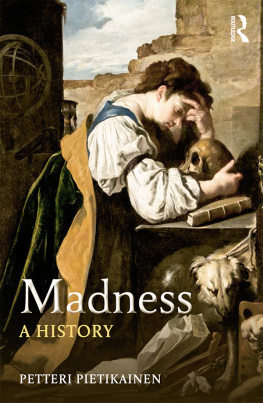First published 2015
by Routledge
2 Park Square, Milton Park, Abingdon, Oxon OX14 4RN
and by Routledge
711 Third Avenue, New York, NY 10017
Routledge is an imprint of the Taylor & Francis Group, an informa business
2015 Petteri Pietikainen
The right of Petteri Pietikainen to be identified as author of this work has been asserted by him in accordance with sections 77 and 78 of the Copyright, Designs and Patents Act 1988.
All rights reserved. No part of this book may be reprinted or reproduced or utilised in any form or by any electronic, mechanical, or other means, now known or hereafter invented, including photocopying and recording, or in any information storage or retrieval system, without permission in writing from the publishers.
Trademark notice: Product or corporate names may be trademarks or registered trademarks, and are used only for identification and explanation without intent to infringe.
British Library Cataloguing-in-Publication Data
A catalogue record for this book is available from the British Library
Library of Congress Cataloging-in-Publication Data
Pietikainen, Petteri.
Madness : a history / Petteri Pietikainen.
pages cm
Includes bibliographical references and index.
1. Mental illnessHistory. 2. Mental illnessSocial aspects
History. 3. Mental illnessTreatmentHistory. 4. Psychiatric
hospitalsHistory. 5. PsychiatryHistory. I. Title.
RC438.P54 2015
616.89dc23
2014045449
ISBN: 978-0-415-71316-0 (hbk)
ISBN: 978-0-415-71318-4 (pbk)
ISBN: 978-1-315-70896-6 (ebk)
Typeset in Bembo
by Apex CoVantage, LLC
Contents
In modern times, the management of madness has oscillated between hope and despair, Utopia and dystopia. In the early nineteenth century, when Philippe Pinel was developing psychiatry on the basis of the humane principles of the Enlightenment and moral treatment, we can see how he and other pioneer psychiatrists were inspired by the vision of the Therapeutic Society. In this better world of the future, the insane would be taken care of, and maybe even cured, by the new scientists and physicians of the soul. The idea and practice of early nineteenth-century moral treatment tried to implement this therapeutic vision with the new type of mental asylums where the insane would regain their senses and be restored to a form of citizenship required in a society bent towards political freedom and democratization. Some scholars have seen the mental asylum in early nineteenth-century France as a laboratory of democracy, where alienists tried to save the glimmer of sanity left in mental patients in order to restore their ability as social beings and autonomous persons (Gauchet & Swain 1999). This short epilogue catalogues the hopes and promises in mental health care and how they remain unfulfilled.
Promises unfulfilled
As the years passed and the initial therapeutic optimism turned to pessimism if not nihilism, nineteenth-century asylums started to resemble vast human warehouses rather than places of cure. The transformation of asylums from houses of cure into custodial institutions signified a grand promise that remained unfulfilled. From the late nineteenth century onwards, the introduction of a number of psychological and somatic therapies seemed to promise a turn for the better: maybe, after all, mental illness can be remedied with the help of psychotherapy, psychoanalysis, various shock methods and, as a last resort, psychosurgery. Psychological therapies were mostly administered to those whose mental afflictions were less severe and who could afford to pay for individual psychotherapeutic sessions. True, in many European countries (e.g. the UK), public health care systems started to provide psychotherapeutic services for patients after World War II, but such services were mostly restricted to the patients treated in out-patient facilities, while institutionalized, more severely ill patients were more or less out of reach of psychotherapy. Moreover, while it was obvious that talk therapy helped some people, to some extent, it was also evident that its therapeutic effect did not often last long, if it had any effect in the first place. As for the somatic therapies, such as insulin coma therapy and electroshocks, their therapeutic effect proved to be transitory. And psychosurgery caused brain damage, which in turn caused a personality change of some degree. Thus, the promise that the new methods of treatment would restore the mental health of patients remained unfulfilled.
The so-called psychopharmacological revolution of the 1950s raised new therapeutic hopes as Thorazine and other neuroleptics seemed to alleviate the condition of institutionalized patients around the world. But it was soon discovered that instead of curing patients the way aspirin cures a headache or antibiotics kill harmful bacteria, Thorazine and other major tranquillizers act as mental stabilizers that, at least in the short term, remove the disturbing symptoms and help the patients cope with the demands of everyday life. The flip side of this psychopharmaceutical coin is that, for too many people, these so-called anti-psychotics impair mental functioning and lessen the quality of life. Moreover, pills create dependence and cause side effects that can be detrimental to both physical and mental health. While psychiatric medications are certainly effective for many people, for many others they are much less so, and for a large minority they do more harm and good. There is accumulating evidence that drugs are much less effective and helpful than has been claimed for decades (Gtzsche 2013; Frances 2013; Healy 2012; Angell 2005). Now that western psychiatry has been drug-centred for half a century, it is relatively safe to conclude that something has gone wrong if more and more people swallow pills and yet there seem to be more and more people with mental illness in the western world. If we are to believe the report published by the US Centers for Disease Control and Prevention, in 2011 a quarter (25 per cent) of the US population suffered from mental illness (Reeves et al. 2011). The psychopharmacological revolution was another promise that remained unfulfilled.
From the late 1950s onwards, so-called deinstitutionalization has turned hospital-based institutional care into community-based (open) care. The therapeutic vision behind this transformation was laudable: let us keep the mentally ill in our communities rather than incarcerating them in large, inhumane institutions; and let us establish outpatient clinics, psychiatric wards in general hospitals, day hospitals and social support rather than locked wards, lobotomies and a numb existence in loony bins. What actually happened between 1960 and 2000 was the reverse of the great confinement of the Asylum Age: the whole structure of the asylum system was disassembled as the number of mental hospital beds was reduced to one-tenth or so of what it had been during the heyday of asylums. It is a contested issue whether national governments and the states in the United States had any intention of investing in mental health care beyond what was necessary to keep up the appearance of organized care. Closing down asylums was economically beneficial to the public authorities, but to what extent were they prepared to spend money to create community services for mental patients, the great majority of whom were no longer sheltered and cared for in hospitals? Sadly, not much, and a solid infrastructure of mental health services is still missing in most if not all western countries. As a consequence of deinstitutionalization, homelessness skyrocketed, for example in the UK and the United States, and a growing number of mental patients ended up on the streets, in jails or in shelters for the homeless. A leading figure in the UK mental health politics, Baroness Elaine Murphy, titled her account of community care between 1962 and 1990 The Disaster Years (Taylor 2014, 116). To speak of the mental health care system is to speak of the most recent unfulfilled promise.









